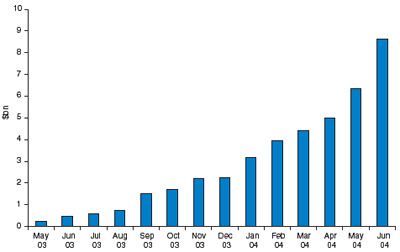
Banks look to boost first-to-default baskets

The latest stage in the evolution of the credit derivatives market took place in July with the emergence of standardised first-to-default (FTD) basket swaps.
Until now, FTDs have typically been tailor-made products for taking credit views, with the investor deciding which names should go into the underlying basket. But now, the three banks involved in standardising them, BNP Paribas, JP Morgan and Morgan Stanley, hope their move to commoditise FTD baskets will make the product cheaper while increasing liquidity.
“The purpose of these is to create FTD baskets that are more liquid than customised baskets, and hence open up the asset class to investors who need to have readily observable levels and an ability to exit a product,” says JP Morgan in a research note introducing the product to the market.
FTD basket swaps are a specialised type of basket default swap – a grouping of credit default swaps (CDS) designed to transfer credit risk with respect to multiple reference entities. With FTD baskets, the protection seller is exposed to the first reference entity in the basket for which a credit event occurs.
The price of a FTD basket depends on the price of the underlying CDS and on the implied correlation between the reference credits, which means the product lets investors take a view not only on the default probability of companies but also on the correlation between entities.
Protection sellers typically receive a lower premium for high correlation FTD basket swaps. This is because, if a credit event takes place on one of the underlyings, the probability of the rest of the underlying credits also succumbing to credit events is relatively high, and yet the protection buyer only receives a payout based on the CDS price of the first defaulted company.
In a credit environment characterised by low spreads and low volatility, as investors are faced with at the moment, FTD basket swaps are a relatively simple method of gaining leveraged exposure to credit spreads.
The banks behind the standardised FTD baskets have applied a rules-based approach to creating the baskets, with the intention to remove any subjectivity and give the baskets credibility in the market. In line with Dow Jones’ credit derivatives indexes, there are 11 sector-based baskets with a five-year maturity. There is also a diversified basket containing one name from each of the other sectors apart from the financials and crossover sectors.
The spread information – five-year mid-CDS spreads – used to create the baskets is supplied by independent data company Mark-it Partners. Entities with no spreads are removed, as are the two names with the lowest spread in each sector. The top five names in each sector, in terms of liquidity, are then used to construct each basket.
JP Morgan says it expects the FTD baskets to become instruments that trade from pure market supply and demand rather than from models, as is the case for index tranches. The intention, says the bank, is to supply “a simple, open and transparent model to enable the calculation of implied correlations from the quoted level of spreads”.
Basket space
“In CDOs [collateralised debt obligations] we have standardised tranches, so people can see where correlation is trading in the tranched space. But now we’re letting investors see what’s happening in the basket space,” says Andrew Palmer, global head of credit derivatives marketing at JP Morgan.
Palmer adds that the product should attract those that until now have not been keen to trade correlation. “Asset managers and some insurance companies have shown hesitation to trade FTD baskets because they can’t see market prices on the products on a regular basis. Now they can. And they can get their books marked by multiple dealers on the same baskets.”
Morgan Stanley says the affiliation of FTD baskets with the Dow Jones suite of indexes, combined with an anticipated increase in the number of dealers trading the product, should serve as a catalyst to boost the trading of FTD baskets to a new level.
“The explosive growth evidenced in tranched synthetic CDOs as a result of their association with the Dow Jones CDX/iTraxx suite of products may be a proxy for the future growth of the FTD market,” says Morgan Stanley in a research note.
In one year, Morgan Stanley’s weekly average volume of US tranched products has increased 11 fold (see figure 1). “The Dow Jones CDX/iTraxx experience has taught us that when many dealers trade a standardised product, liquidity tends to follow,” says Morgan Stanley.
| 1. Morgan Stanley US tranched Dow Jones CDX/Trac-X cumulative volume traded |
|
Only users who have a paid subscription or are part of a corporate subscription are able to print or copy content.
To access these options, along with all other subscription benefits, please contact info@risk.net or view our subscription options here: http://subscriptions.risk.net/subscribe
You are currently unable to print this content. Please contact info@risk.net to find out more.
You are currently unable to copy this content. Please contact info@risk.net to find out more.
Copyright Infopro Digital Limited. All rights reserved.
As outlined in our terms and conditions, https://www.infopro-digital.com/terms-and-conditions/subscriptions/ (point 2.4), printing is limited to a single copy.
If you would like to purchase additional rights please email info@risk.net
Copyright Infopro Digital Limited. All rights reserved.
You may share this content using our article tools. As outlined in our terms and conditions, https://www.infopro-digital.com/terms-and-conditions/subscriptions/ (clause 2.4), an Authorised User may only make one copy of the materials for their own personal use. You must also comply with the restrictions in clause 2.5.
If you would like to purchase additional rights please email info@risk.net
More on Credit markets
Liquidnet sees electronic future for grey bond trading
TP Icap’s grey market bond trading unit has more than doubled transactions in the first quarter of 2024
Single-name CDS trading bounces back
Volumes are up as Covid-driven support fuels opportunity for traders and investors
Podcast: Richard Martin on improving credit migration models
Star quant proposes a new model for predicting changes in bond ratings
CME to pass on Ice CDS administration charges
Clearing house to hike CDS index trade fees from July after Ice’s determinations committee takeover
Buy side fuels boom in single-name CDS clearing
Ice single-name CDS volumes double year on year following switch to semi-annual rolls
Ice to clear single-name bank CDSs from April 10
US participants will be able to start clearing CDSs referencing Ice clearing members
iHeart CDS saga sparks debate over credit rules
Trigger decision highlights product's weaknesses, warns Milbank’s Williams
TLAC-driven CDS index change tipped for September
UK and Swiss bank Holdco CDSs likely inclusions in next iTraxx index roll, say strategists








